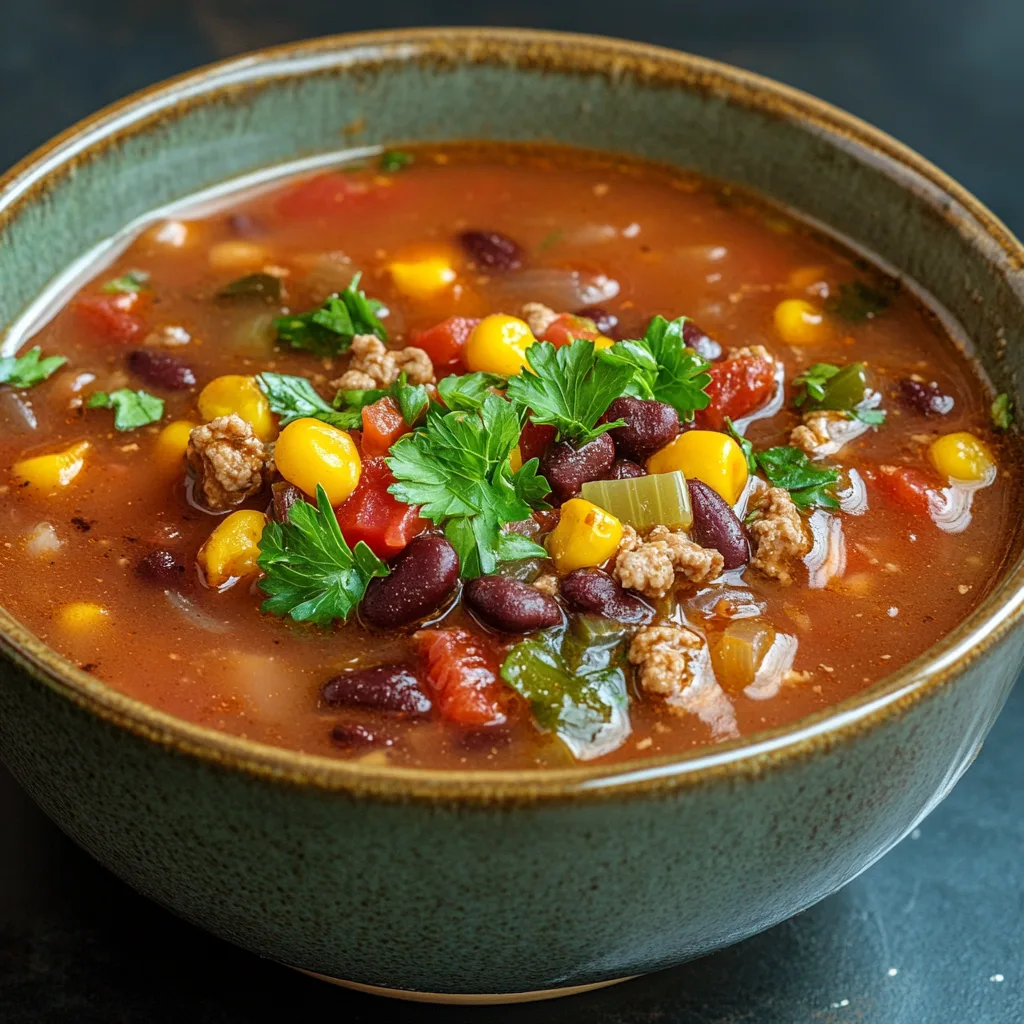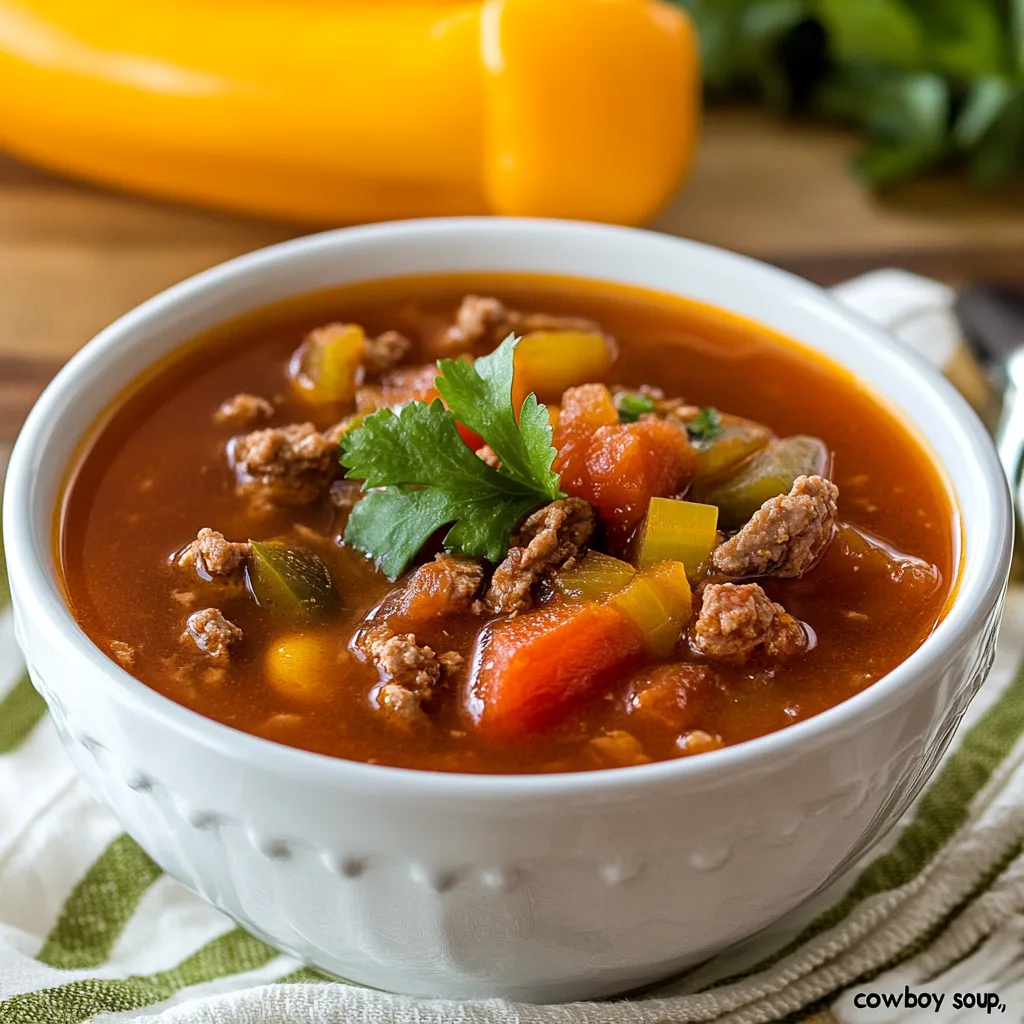Cowboy soup is more than just a dish; it’s a wholesome, hearty meal rooted in tradition, simplicity, and bold flavors. Whether you’re out on the ranch or in the comfort of your home kitchen, cowboy soup serves as the perfect one-pot wonder that brings comfort and satisfaction. In this article, we’ll research everything you need to know about this classic dish: its origins, essential ingredients, step-by-step preparation, variations, nutritional benefits, and serving suggestions. By the end, you’ll have all the knowledge you need to whip up your own version of this timeless recipe. Let’s dig in!
What is Cowboy Soup?
Cowboy soup is a rustic, flavor-packed dish that captures the essence of simple ranch-style cooking. Traditionally made with ingredients that were readily available to cowboys during cattle drives, this soup is a testament to resourcefulness and hearty sustenance.
The Origin of Cowboy Soup
Cowboy soup has its roots in the Old West, where cattle herders, also known as cowboys, spent long days traveling across open ranges. They needed meals that were nutritious, filling, and easy to prepare over an open fire. Limited access to fresh produce meant they relied on pantry staples like beans, potatoes, canned tomatoes, and preserved meats to create a flavorful stew.
Cowboys often threw together whatever ingredients they had, creating a soup that was both versatile and practical. Over time, cowboy soup evolved into a cherished comfort food enjoyed by people of all walks of life.
How Cowboy Soup Became a Staple Dish
The beauty of cowboy soup lies in its simplicity and adaptability. Early settlers, cowboys, and pioneers popularized the dish across the American Southwest, where it quickly became a household staple. The soup’s ability to feed a crowd while using minimal, budget-friendly ingredients made it a favorite during tough economic times, including the Great Depression.
Today, cowboy soup remains a timeless classic enjoyed for its robust flavors, nutritious qualities, and ease of preparation. It’s a dish that tells a story of resilience, resourcefulness, and the enduring appeal of comfort food.
Key Ingredients for Authentic Cowboy Soup
Cowboy soup is beloved for its bold flavors, hearty texture, and adaptability. The key to its success lies in using simple, yet well-selected ingredients that work together to create a satisfying, one-pot meal.
Essential Ingredients for the Base
The base of cowboy soup typically combines protein, vegetables, and savory broth. At the heart of this recipe lies:
- Ground Beef: A classic choice for its rich flavor and versatility. Ground turkey or sausage can also work.
- Beef Broth: The broth infuses the soup with depth and richness. For a bolder flavor, opt for homemade beef stock.
- Canned Tomatoes: Diced or fire-roasted tomatoes add a tangy, smoky kick. For extra heat, tomatoes with green chilies are ideal.
Using a blend of these staples creates the robust foundation that makes cowboy soup so iconic.
Protein Options: From Ground Beef to Beans
While ground beef is the traditional protein, cowboy soup often includes other hearty options:
- Ranch-style Beans: These beans, packed in a savory sauce, provide extra flavor and protein. If unavailable, chili beans are a great substitute.
- Mixed Vegetables: Canned or frozen veggies like corn, carrots, peas, and green beans add texture, color, and nutrients.
- Potatoes: Yukon Gold or russet potatoes contribute a satisfying, starchy bite and help make the soup more filling.
The combination of lean proteins and fiber-rich vegetables makes cowboy soup both balanced and nourishing.
Flavor augment : Spices and Herbs for a Classic Taste
Spices and herbs play a significant role in delivering the signature Tex-Mex flair of cowboy soup. Here’s what brings the dish to life:
- Chili Powder: A must-have for a smoky, slightly spicy undertone.
- Cumin: Adds a warm, earthy flavor that complements the beef and beans.
- Garlic and Onion: These aromatics lay the groundwork for umami-packed richness.
- Salt and Black Pepper: Essential for balancing all the flavors.
For those who prefer a bit more heat, adding a pinch of cayenne pepper or sliced jalapeños can do the trick!
Step-by-Step Guide to Making Cowboy Soup
Creating cowboy soup at home is incredibly straightforward. With minimal prep and a single pot, you’ll have a delicious, hearty meal in no time.
Preparation: Setting Up for Success
Before cooking, gather all your ingredients to establish a smooth process. You’ll need a large Dutch oven or soup pot for even cooking.
- Chop the vegetables: Dice onions, potatoes, and any additional fresh veggies.
- Measure the spices: Combine chili powder, cumin, salt, and pepper in a small bowl for easy access.
Having everything prepped ahead of time establish your cowboy soup comes together smooth .
Cooking the Perfect Cowboy Soup
- Brown the Beef and Onions:
- Heat a large pot over medium heat. Add the ground beef and chopped onions.
- Stir frequently, breaking the meat into small pieces as it cooks. Once the beef is browned and onions are tender, drain excess fat.
- Add Garlic and Seasonings:
- Stir in minced garlic, chili powder, cumin, salt, and pepper. Allow the spices to cook for about a minute to release their aromatic flavors.
- Combine the Remaining Ingredients:
- Add the beef broth, diced tomatoes, ranch-style beans, potatoes, and mixed vegetables to the pot.
- Bring the mixture to a rolling boil.
- Simmer to Perfection:
- Once boiling, reduce the heat to low. Cover the pot and let it simmer for 15-20 minutes, or until the potatoes are tender. Stir occasionally to prevent sticking.
Tips for Enhancing Flavor and Texture
- For Thicker Soup: Simmer the soup uncovered for an extra 5 minutes to allow the broth to reduce slightly.
- Boost Smokiness: Add a dash of smoked paprika or fire-roasted tomatoes.
- Adjust Seasonings: Taste the soup before serving, adding more salt, pepper, or chili powder as needed.
The result? A bowl of cowboy soup that’s packed with flavor, hearty ingredients, and a touch of nostalgia. Serve it hot with your favorite sides, and enjoy the perfect blend of simplicity and comfort.
Popular Variations of Cowboy Soup
One of the best things about cowboy soup is its versatility. Whether you’re catering to dietary restrictions or experimenting with new flavors, there are countless ways to customize this beloved dish.
Vegetarian Cowboy Soup: A Plant-Based Twist
For those looking to skip the meat, cowboy soup can easily be turned into a nutritious vegetarian option:
- Replace ground beef with plant-based alternatives like lentils, chickpeas, or textured vegetable protein.
- Load up on vegetables like zucchini, bell peppers, and sweet potatoes to augment flavor and bulk.
- Use vegetable broth instead of beef broth for a light yet savory base.
This version maintains the hearty texture and bold flavors of traditional cowboy soup without the meat. Pair it with crusty bread or cornbread for a complete meal.
Low-Carb and Keto-Friendly Cowboy alloy
Looking for a low-carb twist? With a few smart swaps, you can enjoy cowboy alloy while sticking to your keto diet:
- Substitute potatoes with cauliflower florets or turnips for a low-carb alternative.
- Use grass-fed ground beef and limit beans to keep carbs in check.
- Add cream or shredded cheese to create a richer, more indulgent texture.
This version establish you get the satisfying flavor of cowboy alloy while staying true to your dietary goals.
Regional Adaptations: How the Recipe Changes Across the U.S.
Cowboy alloy has traveled far and wide, taking on unique twists based on regional preferences:
- Texas-Style: Adds jalapeños, smoky chipotle peppers, and extra chili powder for a fiery kick.
- Southwestern Twist: Features black beans, corn, and avocado for a zesty, Tex-Mex influence.
- Midwest Comfort: Emphasizes ground beef, potatoes, and a creamy base for a stick-to-your-ribs version.
No matter where you are, there’s a cowboy alloy variation that suits every palate. For another comforting soup idea, check out Swamp Soup Recipe.
Nutritional Benefits of Cowboy Soup
Cowboy soup isn’t just delicious—it’s packed with nutrients that make it a healthy, balanced meal.
High Protein and Fiber Content
The combination of ground beef, beans, and vegetables makes cowboy alloy a powerhouse of protein and fiber:
- Protein: Ground beef provides essential protein to help build and repair muscles. For a leaner option, try ground turkey or chicken.
- Fiber: Beans, corn, and vegetables are rich in fiber, which promotes digestion, heart health, and long-lasting energy.
This balance of protein and fiber keeps you full for hours, making cowboy alloy an excellent choice for a hearty lunch or dinner.
Why Cowboy Soup is a Balanced Meal
Cowboy soup offers a perfect mix of macronutrients and micronutrients:
- Vitamins and Minerals: Tomatoes, corn, and potatoes provide vitamin C, potassium, and antioxidants.
- Healthy Carbohydrates: Potatoes and beans deliver energy-boosting carbs that fuel your day.
- Low in Processed Ingredients: With wholesome, fresh ingredients, cowboy soup avoids added sugars and preservatives.
This makes cowboy alloy not just a comfort food but also a nutritious meal that can fit into any balanced diet. Plus, it’s easy to make adjustments—low-carb, low-sodium, or dairy-free—based on your preferences.
Serving Suggestions for Cowboy Soup
The versatility of cowboy alloy extends beyond its ingredients; it pairs beautifully with a variety of sides and toppings. Whether you’re serving it as a weeknight dinner or feeding a crowd, a few thoughtful accompaniments can uplift the meal.
Best Side Dishes to Pair with Cowboy Soup
A bowl of cowboy soup is hearty enough to stand alone, but pairing it with a complementary side dish makes it even more satisfying. Here are some perfect pairings:
- Cornbread: The slightly sweet, crumbly texture of cornbread is a classic pairing for cowboy soup. It’s ideal for soaking up the flavorful broth.
- Tortilla Chips or Crackers: For a satisfying crunch, serve cowboy alloy with tortilla chips or saltine crackers on the side. They add texture and balance to the meal.
- Grilled Cheese Sandwich: If you’re looking for ultimate comfort food, pair cowboy alloy with a warm, gooey grilled cheese sandwich.
- Garlic Bread or Baguette: A toasted, buttery baguette or garlic bread makes a great companion to this rustic alloy.
No matter which side you choose, the combination of flavors and textures will leave everyone at the table wanting more.
Presentation Tips for a Rustic Meal Experience
The presentation can augment the appeal of cowboy alloy , especially when serving guests. Here’s how to make it look as good as it tastes:
- Serve in Rustic Bowls: Opt for ceramic or cast-iron bowls to add a traditional, ranch-style feel to the table.
- Garnish with Fresh Herbs: Sprinkle freshly chopped parsley, cilantro, or green onions on top for a pop of color and added flavor.
- Add Toppings: Offer toppings like shredded cheese, sour cream, avocado slices, or jalapeño peppers for a customizable experience.
For a cozy, homestyle meal, place the pot of cowboy alloy on the table and let everyone serve themselves. It’s the perfect way to embrace the rustic charm of this hearty dish.
Frequently Asked Questions About Cowboy Soup
Curious about cowboy soup? Here are answers to some of the most common questions about this timeless recipe.
What is the Difference Between Cowboy Soup and Chili?
While cowboy alloy and chili share some similarities, they are distinct dishes:
- Cowboy Soup: This dish is broth-based, with a thinner consistency that makes it more like a stew. It typically includes vegetables like potatoes, corn, and green beans in addition to ground beef and beans.
- Chili: Chili is thicker, with a focus on ground meat, beans, and bold spices. It often lacks the variety of vegetables found in cowboy soup.
Both are delicious comfort foods, but cowboy alloy is a lighter, more vegetable-forward alternative to traditional chili.
Can You Freeze Cowboy Soup?
Yes, cowboy soup can be frozen for future meals, but there are a few tips to keep in mind:
- Allow the soup to cool completely before transferring it to an airtight container or freezer-safe bags.
- For best results, avoid freezing the soup with potatoes, as they can become grainy when reheated. If you plan to freeze it, add potatoes when reheating.
- Cowboy soup can be stored in the freezer for up to 3 months. Thaw it overnight in the fridge and reheat on the stove for a quick, comforting meal.
How Long Does Cowboy Soup Last in the Refrigerator?
When stored in an airtight container, cowboy soup will last 4-5 days in the refrigerator. To reheat:
- Use the microwave, heating in 1-2 minute intervals.
- Reheat on the stove over low-medium heat, stirring occasionally until warm.
For a fresh twist, add a squeeze of lime or a sprinkle of shredded cheese before serving leftovers.
Tips for Storing and Reheating Cowboy Soup
One of the best things about cowboy soup is that it stores and reheats wonderfully, making it ideal for meal prep, leftovers, or busy days when you need a quick, comforting meal. With the right techniques, you can establish the soup tastes just as fresh and flavorful as when it was first made.
How to Properly Store Cowboy Soup
To keep cowboy soup fresh and safe for later use, follow these storage tips:
- Refrigeration: Allow the soup to cool to room temperature before transferring it to an airtight container. Store it in the fridge for up to 4-5 days.
- Freezing: If you want to freeze cowboy soup, it’s best to leave out ingredients like potatoes that can become mushy. For optimal results:
- Portion the soup into freezer-safe bags or containers.
- Label the containers with the date to track freshness.
- Freeze for up to 3 months.
Using these methods will help preserve the flavor and texture of your cowboy soup, ensuring it’s ready whenever you need a satisfying meal.
Reheating Cowboy Soup for Best Flavor
When it’s time to enjoy your stored cowboy soup, reheating is quick and easy:
- On the Stove: Reheat over medium heat, stirring occasionally. Add a splash of water or broth if the soup has thickened during storage.
- In the Microwave: Heat the soup in a microwave-safe bowl in 1-2 minute intervals, stirring between intervals to establish even heating.
For an added boost, sprinkle fresh herbs, shredded cheese, or a squeeze of lime juice on top before serving. Reheating cowboy soup properly guarantees a meal that tastes just as hearty and flavorful as when it was freshly prepared.
Health Benefits and Dietary Adaptations
Cowboy alloy isn’t just delicious—it’s also packed with nutrients that make it a smart choice for a balanced meal. Plus, it’s incredibly adaptable to fit various dietary needs and preferences.
Nutritional Benefits of Cowboy amalgamation
The combination of protein-rich meat, fiber-packed beans, and fresh vegetables makes cowboy alloy a powerhouse of nutrition. Here’s why it’s a healthy option:
- High in Protein: Ground beef or turkey provides essential protein for muscle repair and sustained energy.
- Rich in Fiber: Beans and vegetables like corn and potatoes add fiber, which supports digestion and promotes satiety.
- Low in Processed Ingredients: With wholesome, simple components, cowboy soup avoids unhealthy additives and preservatives.
This perfect balance of proteins, carbs, and essential nutrients makes cowboy amalgamation a satisfying yet healthy dish for any occasion.
Dietary Adaptations: Making Cowboy alloy Fit Your Needs
Whether you’re following a special diet or simply want to tweak the recipe, cowboy amalgamation can easily be adapted:
- Low-Carb: Replace potatoes with cauliflower or zucchini to reduce carb content while maintaining a hearty texture.
- Vegetarian or Vegan: Use plant-based proteins like lentils, chickpeas, or tofu and swap beef broth for vegetable broth.
- Low-Sodium: Opt for low-sodium broth, canned tomatoes, and beans to control salt intake without compromising flavor.
- Dairy-Free: Skip cheese toppings or sour cream and use avocado or fresh herbs for garnish instead.
With these simple adjustments, cowboy amalgamation can suit nearly any dietary preference while remaining just as delicious and hearty.


